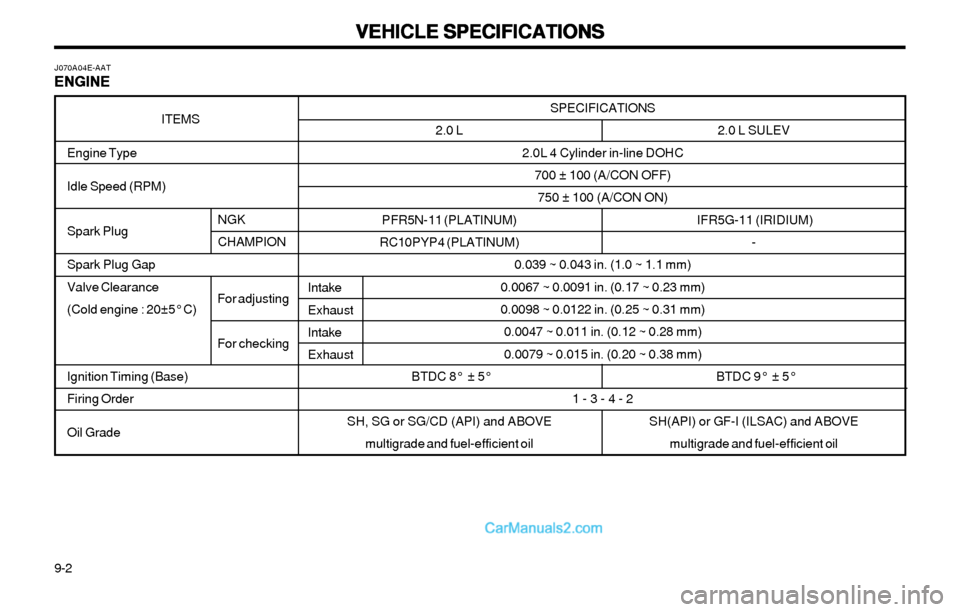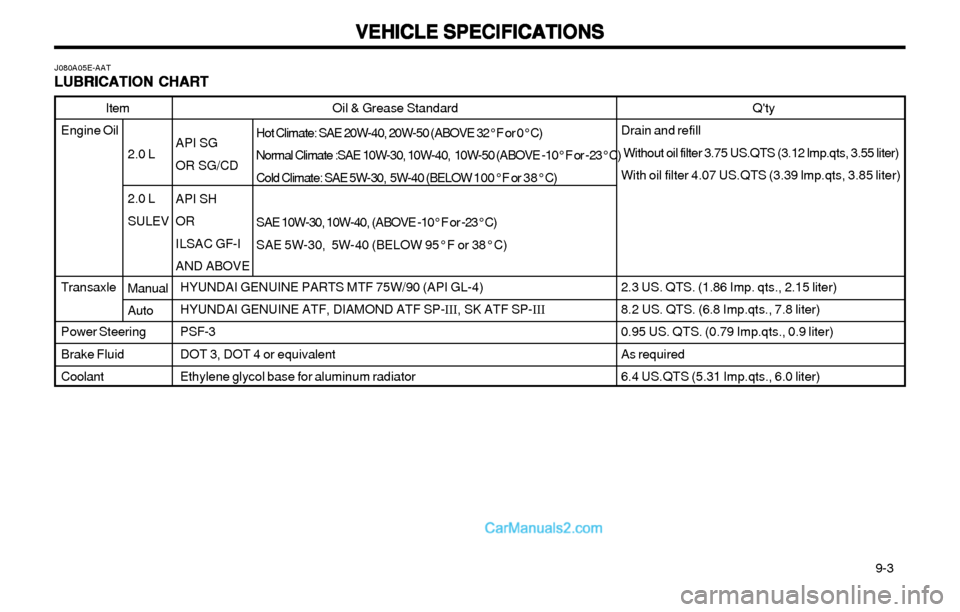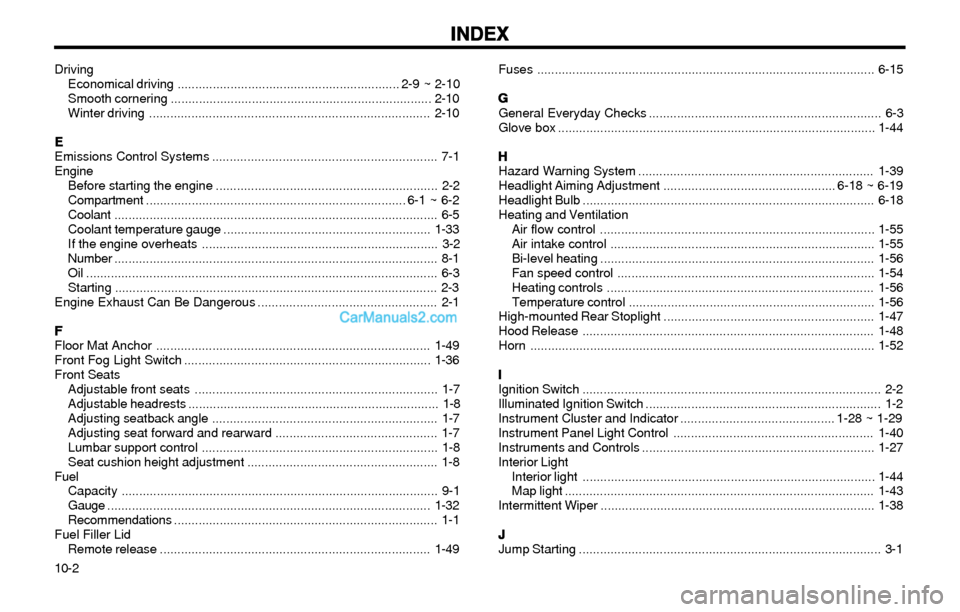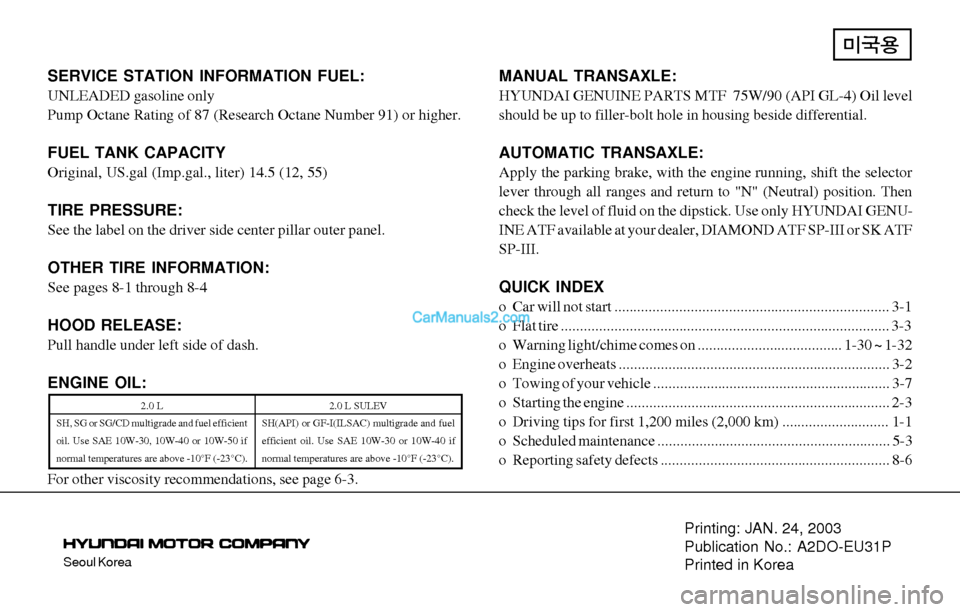Engine Hyundai Elantra 2003 Repair Manual
[x] Cancel search | Manufacturer: HYUNDAI, Model Year: 2003, Model line: Elantra, Model: Hyundai Elantra 2003Pages: 172, PDF Size: 2.82 MB
Page 155 of 172

DO-IT-YOURSELF MAINTENANCE DO-IT-YOURSELF MAINTENANCEDO-IT-YOURSELF MAINTENANCE DO-IT-YOURSELF MAINTENANCE
DO-IT-YOURSELF MAINTENANCE
6-19
If the vehicle has had front body repair and the
headlight assembly has been replaced, the
headlight aiming should be checked using an
aiming screen as shown in the illustration. Turn
on the headlight switch. (Low Beam Position)
1. Adjust headlights so that main axis of light is
parallel to center line of the body and is
aligned with point "P" shown in the illustra-
tion.
2. Dotted lines in the illustration show the cen-
ter of headlights.
SPECIFICATION: SPECIFICATION:SPECIFICATION: SPECIFICATION:
SPECIFICATION:
"H"
Horizontal center line of headlights from
ground.
Low beam : 26.2 in. (639 mm)
High beam : 25.8 in. (629 mm)
"W"
Distance between each headlight center.
Low beam : 45.9 in. (1,120 mm)
High beam : 34.4 in. (840 mm)
"L"
Distance between the headlights and the
wall that the lights are tested against.118 in.
(3,000 mm).
G290B02E-AATAdjustment After Headlight Assembly Adjustment After Headlight AssemblyAdjustment After Headlight Assembly Adjustment After Headlight Assembly
Adjustment After Headlight Assembly
Replacement ReplacementReplacement Replacement
Replacement
G290A03E-AATHEADLI HEADLIHEADLI HEADLI
HEADLI
GHT AIMING ADJUSTMENT GHT AIMING ADJUSTMENTGHT AIMING ADJUSTMENT GHT AIMING ADJUSTMENT
GHT AIMING ADJUSTMENTBefore performing aiming adjustment, make sure
of the following.
1. Keep all tires inflated to the correct pres-
sure.
2. Place the vehicle on level ground and press
the front bumper & rear bumper down sev-
eral times. Place the vehicle at a distance of
118 in. (3,000 mm) from the test wall.
3. See that the vehicle is unloaded (except for
full levels of coolant, engine oil and fuel, and
spare tire, jack, and tools). Have the driver
or equivalent weight placed in driver's seat.
4. Clean the head light lenses and turn on the
headlights (Low beam).
G290A01E
G290B01S
Vertical
line
Cut-off line
Ground line Horizontal line
LW
H
H
"P"
0.8in.
Vertical aiming
5. Open the hood.
6. Draw the vertical line (through the center of
each headlight beam pattern) and the hori-
zontal line (through the center of each head-
light beam pattern) on the aiming screen.
And then, draw the horizontal parallel line at
0.8 in. (21 mm) under the horizontal line.
7. Adjust each cut-off line of the low beam to
the parallel line with a phillips screwdriver
- VERTICAL AIMING
WARNING: WARNING:WARNING: WARNING:
WARNING:Horizontal aiming should be adjusted by an Horizontal aiming should be adjusted by anHorizontal aiming should be adjusted by an Horizontal aiming should be adjusted by an
Horizontal aiming should be adjusted by an
authorized Hyundai Dealer. authorized Hyundai Dealer.authorized Hyundai Dealer. authorized Hyundai Dealer.
authorized Hyundai Dealer.
Page 157 of 172

EMISSION CONTROL SYSTEMS EMISSION CONTROL SYSTEMSEMISSION CONTROL SYSTEMS EMISSION CONTROL SYSTEMS
EMISSION CONTROL SYSTEMS
7-1
7. 7.7. 7.
7.
EMISSION EMISSIONEMISSION EMISSION
EMISSION
CONTR CONTRCONTR CONTR
CONTR
OL OLOL OL
OL
SYSTEMS SYSTEMSSYSTEMS SYSTEMS
SYSTEMSH010B01A-AAT1. 1.1. 1.
1.
Crankcase Emission Control Crankcase Emission ControlCrankcase Emission Control Crankcase Emission Control
Crankcase Emission Control
System SystemSystem System
System
The Positive Crankcase Ventilation System is
employed to prevent air pollution caused by
blow-by gases being emitted from the crank-
case. This system supplies fresh filtered air to
the crankcase through the air intake hose.
Inside the crankcase, the fresh air mixes with
blow-by gases, which then pass through the
PCV valve and into the induction system.
H010C01S-AAT2. Evaporative Emission Control (In- 2. Evaporative Emission Control (In-2. Evaporative Emission Control (In- 2. Evaporative Emission Control (In-
2. Evaporative Emission Control (In-
cluding ORVR: Onboard Refueling cluding ORVR: Onboard Refuelingcluding ORVR: Onboard Refueling cluding ORVR: Onboard Refueling
cluding ORVR: Onboard Refueling
Vapor Recovery) System Vapor Recovery) SystemVapor Recovery) System Vapor Recovery) System
Vapor Recovery) System
The Evaporative Emission Control System is
designed to prevent fuel vapors from escaping
into the atmosphere.
(The ORVR system is designed to allow the (The ORVR system is designed to allow the(The ORVR system is designed to allow the (The ORVR system is designed to allow the
(The ORVR system is designed to allow the
vapors from the fuel tank to be loaded into vapors from the fuel tank to be loaded intovapors from the fuel tank to be loaded into vapors from the fuel tank to be loaded into
vapors from the fuel tank to be loaded into
a canister while refueling at the gas station, a canister while refueling at the gas station,a canister while refueling at the gas station, a canister while refueling at the gas station,
a canister while refueling at the gas station,
preventing the escape of fuel vapors into preventing the escape of fuel vapors intopreventing the escape of fuel vapors into preventing the escape of fuel vapors into
preventing the escape of fuel vapors into
the atmosphere.) the atmosphere.)the atmosphere.) the atmosphere.)
the atmosphere.)
Canister CanisterCanister Canister
CanisterFuel vapors generated inside the fuel tank are
absorbed and stored in the onboard canister.
When the engine is running, the fuel vapors
absorbed in the canister are drawn into the
induction system through the purge control so-
lenoid valve.
Purge Control Solenoid Valve (PCSV) Purge Control Solenoid Valve (PCSV)Purge Control Solenoid Valve (PCSV) Purge Control Solenoid Valve (PCSV)
Purge Control Solenoid Valve (PCSV)The purge control solenoid valve is controlled
by the Engine Control Module (ECM); when the
engine coolant temperature is low during idling,
the PCSV closes so that evaporated fuel is not
taken into the engine. After the engine warms-
up during ordinary driving, the PCSV opens to
introduce evaporated fuel to the engine.
H010D01A-AAT
3. 3.3. 3.
3.
Exhaust Emission Control System Exhaust Emission Control SystemExhaust Emission Control System Exhaust Emission Control System
Exhaust Emission Control SystemThe Exhaust Emission Control System is a
highly effective system which controls exhaust
emissions while maintaining good vehicle
performace.
H010A01A-AAT
EMISSION CONTROL SYSTEM EMISSION CONTROL SYSTEMEMISSION CONTROL SYSTEM EMISSION CONTROL SYSTEM
EMISSION CONTROL SYSTEMYour Hyundai is equipped with an emission
control system to meet all requirements of the
U.S. Environmental Protection Agency or Cali-
fornia Air Resources Board.
There are three emission control systems which
are as follows.
1) Crankcase Emission Control System
2) Evaporative Emission Control System
3) Exhaust Emission Control System
In order to ensure the proper function of the
emission control systems, it is recommended
that you have your car inspected and main-
tained by an authorized Hyundai dealer in ac-
cordance with the maintenance schedule in this
manual.
H020A01S-AAT
CATALYTIC CONVERTER CATALYTIC CONVERTERCATALYTIC CONVERTER CATALYTIC CONVERTER
CATALYTIC CONVERTER
Catalytic Converter
(California)
SSA7020A
Catalytic Converter
(Federal, California)
7 77 7
7
Page 158 of 172

7-2
EMISSION CONTROL SYSTEMS EMISSION CONTROL SYSTEMSEMISSION CONTROL SYSTEMS EMISSION CONTROL SYSTEMS
EMISSION CONTROL SYSTEMS
All Hyundai vehicles are equipped with one or
two monolith type three-way catalytic convert-
ers to reduce the carbon monoxide, hydrocar-
bons and nitrogen oxides contained in the ex-
haust gas. Exhaust gases passing through the
catalytic converter cause it to operate at a very
high temperature. The introduction of large
amounts of unburned gasoline into the exhaust
may cause the catalytic converter to overheat
and create a fire hazard. This risk may be
reduced by observing the following:
WARNING: WARNING:WARNING: WARNING:
WARNING:o oo o
o
Use unleaded fuel only. Use unleaded fuel only.Use unleaded fuel only. Use unleaded fuel only.
Use unleaded fuel only.
o oo o
o
Maintain the engine in good operating Maintain the engine in good operatingMaintain the engine in good operating Maintain the engine in good operating
Maintain the engine in good operating
condition. Extremely high catalytic con- condition. Extremely high catalytic con-condition. Extremely high catalytic con- condition. Extremely high catalytic con-
condition. Extremely high catalytic con-
verter temperatures can result from im- verter temperatures can result from im-verter temperatures can result from im- verter temperatures can result from im-
verter temperatures can result from im-
proper operation of the electrical, igni- proper operation of the electrical, igni-proper operation of the electrical, igni- proper operation of the electrical, igni-
proper operation of the electrical, igni-
tion or multiport electronic fuel injection. tion or multiport electronic fuel injection.tion or multiport electronic fuel injection. tion or multiport electronic fuel injection.
tion or multiport electronic fuel injection.
o oo o
o
If your engine stalls, pings, knocks, or is If your engine stalls, pings, knocks, or isIf your engine stalls, pings, knocks, or is If your engine stalls, pings, knocks, or is
If your engine stalls, pings, knocks, or is
hard to start, have your Hyundai dealer hard to start, have your Hyundai dealerhard to start, have your Hyundai dealer hard to start, have your Hyundai dealer
hard to start, have your Hyundai dealer
inspect and repair the problem as soon inspect and repair the problem as sooninspect and repair the problem as soon inspect and repair the problem as soon
inspect and repair the problem as soon
as possible. as possible.as possible. as possible.
as possible.
o oo o
o
Avoid driving with a very low fuel level. Avoid driving with a very low fuel level.Avoid driving with a very low fuel level. Avoid driving with a very low fuel level.
Avoid driving with a very low fuel level.
Running out of gasoline may cause the Running out of gasoline may cause theRunning out of gasoline may cause the Running out of gasoline may cause the
Running out of gasoline may cause the
engine to misfire and result in damage to engine to misfire and result in damage toengine to misfire and result in damage to engine to misfire and result in damage to
engine to misfire and result in damage to
the catalytic converter. the catalytic converter.the catalytic converter. the catalytic converter.
the catalytic converter.
o oo o
o
Avoid idling the engine for periods longer Avoid idling the engine for periods longerAvoid idling the engine for periods longer Avoid idling the engine for periods longer
Avoid idling the engine for periods longer
than 10 minutes. than 10 minutes.than 10 minutes. than 10 minutes.
than 10 minutes.
o oo o
o
The vehicle should not be pushed or The vehicle should not be pushed orThe vehicle should not be pushed or The vehicle should not be pushed or
The vehicle should not be pushed orpulled to get started. This may cause the pulled to get started. This may cause thepulled to get started. This may cause the pulled to get started. This may cause the
pulled to get started. This may cause the
catalytic converter to overheat and cre- catalytic converter to overheat and cre-catalytic converter to overheat and cre- catalytic converter to overheat and cre-
catalytic converter to overheat and cre-
ate a fire hazard. ate a fire hazard.ate a fire hazard. ate a fire hazard.
ate a fire hazard.
o oo o
o
Do not touch the catalytic converter or Do not touch the catalytic converter orDo not touch the catalytic converter or Do not touch the catalytic converter or
Do not touch the catalytic converter or
any other part of the exhaust system any other part of the exhaust systemany other part of the exhaust system any other part of the exhaust system
any other part of the exhaust system
while the catalytic converter is hot. Shut while the catalytic converter is hot. Shutwhile the catalytic converter is hot. Shut while the catalytic converter is hot. Shut
while the catalytic converter is hot. Shut
off the engine, wait for at least one hour off the engine, wait for at least one houroff the engine, wait for at least one hour off the engine, wait for at least one hour
off the engine, wait for at least one hour
before touching the catalytic converter before touching the catalytic converterbefore touching the catalytic converter before touching the catalytic converter
before touching the catalytic converter
or any other part of the exhaust system. or any other part of the exhaust system.or any other part of the exhaust system. or any other part of the exhaust system.
or any other part of the exhaust system.
o oo o
o
Remember that your Hyundai dealer is Remember that your Hyundai dealer isRemember that your Hyundai dealer is Remember that your Hyundai dealer is
Remember that your Hyundai dealer is
your best source of assistance. your best source of assistance.your best source of assistance. your best source of assistance.
your best source of assistance.
o oo o
o
Do not stop your Hyundai over any com- Do not stop your Hyundai over any com-Do not stop your Hyundai over any com- Do not stop your Hyundai over any com-
Do not stop your Hyundai over any com-
bustible material such as grass, paper, bustible material such as grass, paper,bustible material such as grass, paper, bustible material such as grass, paper,
bustible material such as grass, paper,
leaves or rags. These materials might leaves or rags. These materials mightleaves or rags. These materials might leaves or rags. These materials might
leaves or rags. These materials might
contact the hot catalytic converter and a contact the hot catalytic converter and acontact the hot catalytic converter and a contact the hot catalytic converter and a
contact the hot catalytic converter and a
fire might result. fire might result.fire might result. fire might result.
fire might result.
Page 159 of 172

CONSUMER INFORMATION & REPORTING SAFETY DEFECTS CONSUMER INFORMATION & REPORTING SAFETY DEFECTSCONSUMER INFORMATION & REPORTING SAFETY DEFECTS CONSUMER INFORMATION & REPORTING SAFETY DEFECTS
CONSUMER INFORMATION & REPORTING SAFETY DEFECTS
8-1
TEMPORARY USE ONLY
420(60)
8. 8.8. 8.
8.
CONSUMER CONSUMERCONSUMER CONSUMER
CONSUMER
INFORMA INFORMAINFORMA INFORMA
INFORMA
TION & TION &TION & TION &
TION &
REPOR REPORREPOR REPOR
REPOR
TING TINGTING TING
TING
SAFETY DEFECTS SAFETY DEFECTSSAFETY DEFECTS SAFETY DEFECTS
SAFETY DEFECTSI030A02S-AATRECOMMENDED INFLATION RECOMMENDED INFLATIONRECOMMENDED INFLATION RECOMMENDED INFLATION
RECOMMENDED INFLATION
PRESSURES PRESSURESPRESSURES PRESSURES
PRESSURES
The tire label located on the driver's side center
pillar outer panel gives the tire pressures rec-
ommended for your vehicle.
I030A01E
I010A01A-AAT
VEHICLE IDENTIFICATION VEHICLE IDENTIFICATIONVEHICLE IDENTIFICATION VEHICLE IDENTIFICATION
VEHICLE IDENTIFICATION
NUMBER (VIN) NUMBER (VIN)NUMBER (VIN) NUMBER (VIN)
NUMBER (VIN)
The vehicle identification number (VIN) is the
number used in registering your car and in all
legal matters pertaining to its ownership, etc. It
can be found in three different places on your
car:1. On the bulkhead between the engine and
passenger compartments.
2. On the left top side of the instrument panel
where it can be seen by looking down through
the windshield.
3. On the lower side of the center pillar outer
panel.
I010B01A-AAT
Engine Number Engine NumberEngine Number Engine Number
Engine Number
The engine number is stamped on the engine
block as shown in the drawing.
I020A01A-AAT
TIRE INFORMATION TIRE INFORMATIONTIRE INFORMATION TIRE INFORMATION
TIRE INFORMATION
The tires supplied on your new Hyundai are
chosen to provide the best performance for
normal driving.
SSA8010B
I010A01E-1
12
3
8 88 8
8
These pressures were chosen to provide the
most satisfactory combination of ride comfort,
tire wear and stability under normal conditions.
Tire pressures should be checked at least
monthly. Proper tire inflation pressures should
be maintained for these reasons:
TIRE
SIZEPRESSURE, kPa (PSI)
P185/65R15 86T
P195/60R15 87H
T125/70D15
T125/70R15REAR
210(30)
210(30) FRONT
210(30)
210(30)
Page 166 of 172

VEHICLE SPECIFICATIONS VEHICLE SPECIFICATIONSVEHICLE SPECIFICATIONS VEHICLE SPECIFICATIONS
VEHICLE SPECIFICATIONS
9-22.0 L
PFR5N-11 (PLATINUM)
RC10PYP4 (PLATINUM)
BTDC 8° ± 5°
SH, SG or SG/CD (API) and ABOVE
multigrade and fuel-efficient oil2.0 L SULEV
IFR5G-11 (IRIDIUM)
-
BTDC 9° ± 5°
SH(API) or GF-I (ILSAC) and ABOVE
multigrade and fuel-efficient oil SPECIFICATIONS
2.0L 4 Cylinder in-line DOHC
700 ± 100 (A/CON OFF)
750 ± 100 (A/CON ON)
0.039 ~ 0.043 in. (1.0 ~ 1.1 mm)
0.0067 ~ 0.0091 in. (0.17 ~ 0.23 mm)
0.0098 ~ 0.0122 in. (0.25 ~ 0.31 mm)
0.0047 ~ 0.011 in. (0.12 ~ 0.28 mm)
0.0079 ~ 0.015 in. (0.20 ~ 0.38 mm)
1 - 3 - 4 - 2 ITEMS
Engine Type
Idle Speed (RPM)
Spark Plug
Spark Plug Gap
Valve Clearance
(Cold engine : 20±5°C)
Ignition Timing (Base)
Firing Order
Oil Grade
J070A04E-AAT
ENGINE ENGINEENGINE ENGINE
ENGINE
NGK
CHAMPION
For adjusting
For checkingIntake
Exhaust
Intake
Exhaust
Page 167 of 172

VEHICLE SPECIFICATIONS VEHICLE SPECIFICATIONSVEHICLE SPECIFICATIONS VEHICLE SPECIFICATIONS
VEHICLE SPECIFICATIONS
9-3 Oil & Grease Standard
HYUNDAI GENUINE PARTS MTF 75W/90 (API GL-4)
HYUNDAI GENUINE ATF, DIAMOND ATF SP-III, SK ATF SP-III
PSF-3
DOT 3, DOT 4 or equivalent
Ethylene glycol base for aluminum radiatorHot Climate: SAE 20W-40, 20W-50 (ABOVE 32°F or 0°C)
Normal Climate :SAE 10W-30, 10W-40, 10W-50 (ABOVE -10°F or -23°C)
Cold Climate: SAE 5W-30, 5W-40 (BELOW 1 0 0 °F or 3 8 °C)
SAE 10W-30, 10W-40, (ABOVE -10°F or -23°C)
SAE 5W-30, 5W-40 (BELOW 95°F or 38°C)
J080A05E-AAT
LUBRICATION CHART LUBRICATION CHARTLUBRICATION CHART LUBRICATION CHART
LUBRICATION CHART
Item
Engine Oil
Transaxle
Power Steering
Brake Fluid
Coolant
API SG
OR SG/CD
API SH
OR
ILSAC GF-I
AND ABOVE2.0 L
2.0 L
SULEV
Manual
Auto
Q'ty
Drain and refill
Without oil filter 3.75 US.QTS (3.12 lmp.qts, 3.55 liter)
With oil filter 4.07 US.QTS (3.39 lmp.qts, 3.85 liter)
2.3 US. QTS. (1.86 Imp. qts., 2.15 liter)
8.2 US. QTS. (6.8 Imp.qts., 7.8 liter)
0.95 US. QTS. (0.79 Imp.qts., 0.9 liter)
As required
6.4 US.QTS (5.31 Imp.qts., 6.0 liter)
Page 169 of 172

INDEX INDEXINDEX INDEX
INDEX
10-2Driving
Economical driving ............................................................... 2-9 ~ 2-10
Smooth cornering ..........................................................................2-10
Winter driving ................................................................................2-10
E EE E
E
Emissions Control Systems ................................................................ 7-1
Engine
Before starting the engine ............................................................... 2-2
Compartment.......................................................................... 6-1 ~ 6-2
Coolant............................................................................................ 6-5
Coolant temperature gauge ...........................................................1-33
If the engine overheats ................................................................... 3-2
Number............................................................................................ 8-1
Oil .................................................................................................... 6-3
Starting ............................................................................................ 2-3
Engine Exhaust Can Be Dangerous ................................................... 2-1
F FF F
F
Floor Mat Anchor ..............................................................................1-49
Front Fog Light Switch ......................................................................1-36
Front Seats
Adjustable front seats ..................................................................... 1-7
Adjustable headrests ....................................................................... 1-8
Adjusting seatback angle ................................................................ 1-7
Adjusting seat forward and rearward .............................................. 1-7
Lumbar support control ................................................................... 1-8
Seat cushion height adjustment ...................................................... 1-8
Fuel
Capacity .......................................................................................... 9-1
Gauge............................................................................................1-32
Recommendations........................................................................... 1-1
Fuel Filler Lid
Remote release .............................................................................1-49Fuses ................................................................................................6-15
G GG G
G
General Everyday Checks .................................................................. 6-3
Glove box ..........................................................................................1-44
H HH H
H
Hazard Warning System ...................................................................1-39
Headlight Aiming Adjustment ................................................. 6-18 ~ 6-19
Headlight Bulb ...................................................................................6-18
Heating and Ventilation
Air flow control ..............................................................................1-55
Air intake control ...........................................................................1-55
Bi-level heating ..............................................................................1-56
Fan speed control .........................................................................1-54
Heating controls ............................................................................1-56
Temperature control ......................................................................1-56
High-mounted Rear Stoplight ............................................................1-47
Hood Release ...................................................................................1-48
Horn ..................................................................................................1-52
I II I
I
Ignition Switch ..................................................................................... 2-2
Illuminated Ignition Switch ................................................................... 1-2
Instrument Cluster and Indicator ............................................ 1-28 ~ 1-29
Instrument Panel Light Control .........................................................1-40
Instruments and Controls ..................................................................1-27
Interior Light
Interior light ...................................................................................1-44
Map light ........................................................................................1-43
Intermittent Wiper ..............................................................................1-38
J JJ J
J
Jump Starting ...................................................................................... 3-1
Page 172 of 172

Seoul Korea
Printing: JAN. 24, 2003
Publication No.: A2DO-EU31P
Printed in Korea
SERVICE STATION INFORMATION FUEL:
UNLEADED gasoline only
Pump Octane Rating of 87 (Research Octane Number 91) or higher.
FUEL TANK CAPACITY
Original, US.gal (Imp.gal., liter) 14.5 (12, 55)
TIRE PRESSURE:
See the label on the driver side center pillar outer panel.
OTHER TIRE INFORMATION:
See pages 8-1 through 8-4
HOOD RELEASE:
Pull handle under left side of dash.
ENGINE OIL:
For other viscosity recommendations, see page 6-3.
MANUAL TRANSAXLE:
HYUNDAI GENUINE PARTS MTF 75W/90 (API GL-4) Oil level
should be up to filler-bolt hole in housing beside differential.
AUTOMATIC TRANSAXLE:
Apply the parking brake, with the engine running, shift the selector
lever through all ranges and return to "N" (Neutral) position. Then
check the level of fluid on the dipstick. Use only HYUNDAI GENU-
INE ATF available at your dealer, DIAMOND ATF SP-III or SK ATF
SP-III.
QUICK INDEX
o Car will not start ........................................................................ 3-1
o Flat tire ...................................................................................... 3-3
o Warning light/chime comes on ...................................... 1-30 ~ 1-32
o Engine overheats ....................................................................... 3-2
o Towing of your vehicle .............................................................. 3-7
o Starting the engine ..................................................................... 2-3
o Driving tips for first 1,200 miles (2,000 km) ............................ 1-1
o Scheduled maintenance ............................................................. 5-3
o Reporting safety defects ............................................................ 8-6
2.0 L
SH, SG or SG/CD multigrade and fuel efficient
oil. Use SAE 10W-30, 10W-40 or 10W-50 if
normal temperatures are above -10°F (-23°C).2.0 L SULEV
SH(API) or GF-I(ILSAC) multigrade and fuel
efficient oil. Use SAE 10W-30 or 10W-40 if
normal temperatures are above -10°F (-23°C).